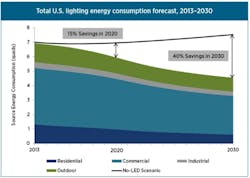DOE releases a report projecting the energy savings that LED sources will deliver
The US Department of Energy predicts that the uptake of LED-based lighting will deliver a 40% reduction in energy usage in the year 2030, equating to $26 billion in savings that year alone.
The US Department of Energy (DOE) has published a new report entitled "Energy savings forecast of solid-state lighting in general illumination applications" that projects the US penetration of solid-state lighting (SSL) into the general lighting market by 2030 and the energy savings that the technology will deliver. LEDs are expected to represent 48% of lumen-hour sales for general illumination products by 2020, and 84% by 2030.
The DOE said that the new report offers a more detailed breakdown of lighting applications relative to prior publications, enabled by more data sources. The report projects LED uptake based on the current state of the technology in terms of efficacy and price. And the report estimates additional penetration that could be achieved if the LED industry can hit DOE projections on efficacy and price.
Based on the current state of the technology, the report projects a 15% reduction in energy consumption attributed to lighting in 2020 and 40% reduction in 2030. As depicted in the nearby graph, the DOE considers a baseline state where there was no further penetration of LED technology into lighting compared relative to the projected deployment of LEDs in a number of application scenarios including commercial, residential, and outdoor. While the projected savings are based on the current efficacy and price levels, the reduction would equate to 3-quad savings (261 TWh) in 2030 or $26B (billion) in that year alone.
The cumulative projections are even more impressive. Over the period from 2013–2030, the DOE projects that cumulative savings would equal 25.3 quads (2216 TWh) or $220B in avoided electrical costs.
The new report isn’t directly comparable to any prior DOE research. For example, a report the DOE issued last year on LED adoption in common applications projected a 71 trillion BTU savings (21 TWh) based on 2013 LED penetration. That report also projected 1135 TWh annual savings with 100% LED penetration in the ten targeted applications, but the DOE didn’t attach a timeline to the projection.
The more aggressive projections made in the new report are tied to advances in efficacy and other performance areas combined with continued price drops. Such developments would increase the penetration of LED technology. Indeed, should the industry meet goals in the DOE SSL roadmap, LED penetration could hit 68% of lumen-hour sales in 2020, and 90% in 2030. Such progress would increase energy conservation by an additional 20%.
The full report is available on the DOE's SSL website. The agency has also posted an interactive model that it utilized in making the projections and which interested parties can use to model the entire lighting market or segments of the market. Indeed, the model allows you to test the impacts of efficacy advancements, price declines, use of controls, and the rate of renovation.

Maury Wright | Editor in Chief
Maury Wright is an electronics engineer turned technology journalist, who has focused specifically on the LED & Lighting industry for the past decade. Wright first wrote for LEDs Magazine as a contractor in 2010, and took over as Editor-in-Chief in 2012. He has broad experience in technology areas ranging from microprocessors to digital media to wireless networks that he gained over 30 years in the trade press. Wright has experience running global editorial operations, such as during his tenure as worldwide editorial director of EDN Magazine, and has been instrumental in launching publication websites going back to the earliest days of the Internet. Wright has won numerous industry awards, including multiple ASBPE national awards for B2B journalism excellence, and has received finalist recognition for LEDs Magazine in the FOLIO Eddie Awards. He received a BS in electrical engineering from Auburn University.





